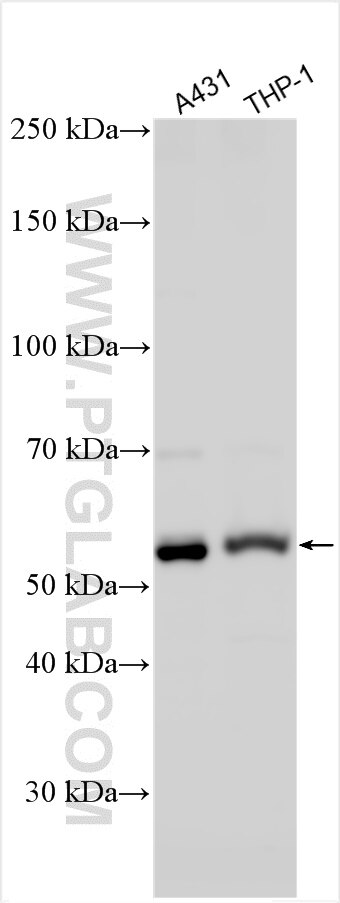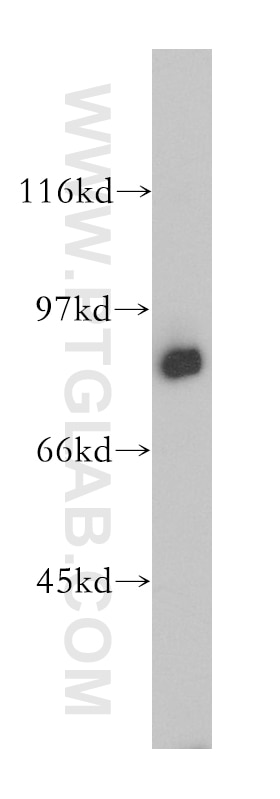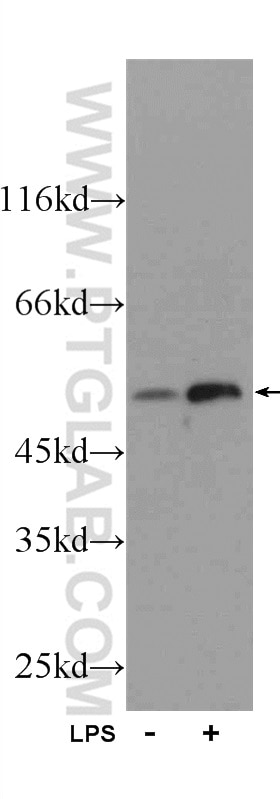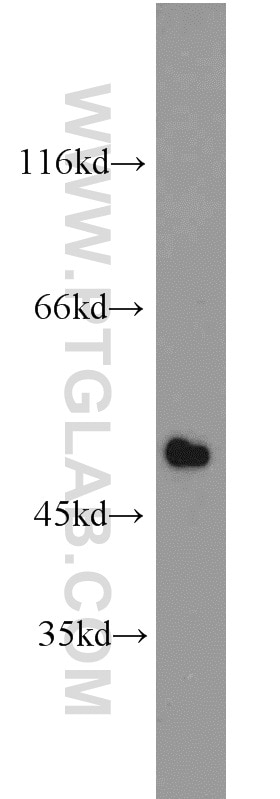- Featured Product
- KD/KO Validated
IFIT2 Polyklonaler Antikörper
IFIT2 Polyklonal Antikörper für WB, IHC, IF/ICC, IP, ELISA
Wirt / Isotyp
Kaninchen / IgG
Getestete Reaktivität
human, Maus
Anwendung
WB, IHC, IF/ICC, IP, ELISA
Konjugation
Unkonjugiert
Kat-Nr. : 12604-1-AP
Synonyme
Galerie der Validierungsdaten
Geprüfte Anwendungen
| Erfolgreiche Detektion in WB | A431-Zellen, RAW 264.7-Zellen, THP-1-Zellen |
| Erfolgreiche IP | A431-Zellen |
| Erfolgreiche Detektion in IHC | humanes Hautkrebsgewebe, humanes Nierengewebe Hinweis: Antigendemaskierung mit TE-Puffer pH 9,0 empfohlen. (*) Wahlweise kann die Antigendemaskierung auch mit Citratpuffer pH 6,0 erfolgen. |
| Erfolgreiche Detektion in IF/ICC | HepG2-Zellen |
Empfohlene Verdünnung
| Anwendung | Verdünnung |
|---|---|
| Western Blot (WB) | WB : 1:500-1:2000 |
| Immunpräzipitation (IP) | IP : 0.5-4.0 ug for 1.0-3.0 mg of total protein lysate |
| Immunhistochemie (IHC) | IHC : 1:50-1:500 |
| Immunfluoreszenz (IF)/ICC | IF/ICC : 1:10-1:100 |
| It is recommended that this reagent should be titrated in each testing system to obtain optimal results. | |
| Sample-dependent, check data in validation data gallery | |
Veröffentlichte Anwendungen
| KD/KO | See 4 publications below |
| WB | See 40 publications below |
| IHC | See 2 publications below |
| IF | See 2 publications below |
Produktinformation
12604-1-AP bindet in WB, IHC, IF/ICC, IP, ELISA IFIT2 und zeigt Reaktivität mit human, Maus
| Getestete Reaktivität | human, Maus |
| In Publikationen genannte Reaktivität | human, Maus |
| Wirt / Isotyp | Kaninchen / IgG |
| Klonalität | Polyklonal |
| Typ | Antikörper |
| Immunogen | IFIT2 fusion protein Ag3283 |
| Vollständiger Name | IFIT 2 |
| Berechnetes Molekulargewicht | 484 aa, 56 kDa |
| Beobachtetes Molekulargewicht | 50-55 kDa |
| GenBank-Zugangsnummer | BC032839 |
| Gene symbol | IFIT2 |
| Gene ID (NCBI) | 3433 |
| Konjugation | Unkonjugiert |
| Form | Liquid |
| Reinigungsmethode | Antigen-Affinitätsreinigung |
| Lagerungspuffer | PBS mit 0.02% Natriumazid und 50% Glycerin pH 7.3. |
| Lagerungsbedingungen | Bei -20°C lagern. Nach dem Versand ein Jahr lang stabil Aliquotieren ist bei -20oC Lagerung nicht notwendig. 20ul Größen enthalten 0,1% BSA. |
Hintergrundinformationen
IFIT2 belongs to the IFIT family. It contains 6 TPR repeats. IFIT genes comprise a large family with three (Ifit1, Ifit2, and Ifit3) and four (IFIT1, IFIT2, IFIT3, and IFIT5) members in mice and humans, respectively. IFIT proteins are produced in human body that are supposed to confer immunity against viral infection. These proteins are generally produced during viral infection, IFN treatment, and during pathogen recognition (Pathogen associated molecular pattern recognition) by immune system during infections.
Protokolle
| Produktspezifische Protokolle | |
|---|---|
| WB protocol for IFIT2 antibody 12604-1-AP | Protokoll herunterladen |
| IHC protocol for IFIT2 antibody 12604-1-AP | Protokoll herunterladen |
| IF protocol for IFIT2 antibody 12604-1-AP | Protokoll herunterladen |
| IP protocol for IFIT2 antibody 12604-1-AP | Protokoll herunterladen |
| Standard-Protokolle | |
|---|---|
| Klicken Sie hier, um unsere Standardprotokolle anzuzeigen |
Publikationen
| Species | Application | Title |
|---|---|---|
Signal Transduct Target Ther TRAF3 activates STING-mediated suppression of EV-A71 and target of viral evasion | ||
Nat Immunol A phosphomimetic-based mechanism of dengue virus to antagonize innate immunity. | ||
Nat Microbiol ISG15-dependent activation of the sensor MDA5 is antagonized by the SARS-CoV-2 papain-like protease to evade host innate immunity. | ||
Nat Microbiol Influenza virus repurposes the antiviral protein IFIT2 to promote translation of viral mRNAs. | ||
Nucleic Acids Res IFIT3 and IFIT2/3 promote IFIT1-mediated translation inhibition by enhancing binding to non-self RNA. |
















